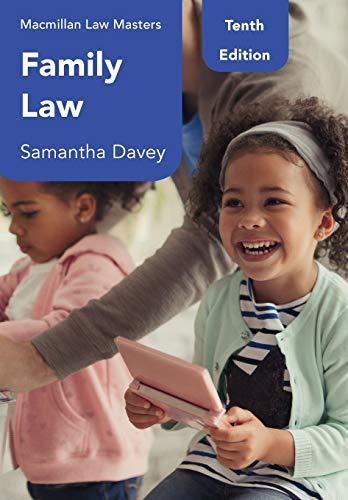Question
Case Brief Instructions Note that, unlike the case have been assigned, the cases in the text have been stripped down to a fundamental legal issue
Case Brief Instructions
Note that, unlike the case have been assigned, the cases in the text have been stripped down to a fundamental legal issue related to the chapter of study and do not contain much of the procedural aspects may find in case.
Topic: Monk vs. Phillips, 983 SW2d 323
Question1. DECIDE ON A FORMAT AND STICK TO IT: Structure is essential to a good brief. It enables to arrange systematically the related parts that are scattered throughout most cases, thus making manageable and understandable what might otherwise seem to be an endless and unfathomable sea of information. There are, of course, an unlimited number of formats that can be utilized. However, it is best to find one that suits needs and stick to it. Consistency breeds both efficiency and the security that when called upon will know where to look in brief for the information are asked to give. Be mindful that the operative word is ideally the case brief should be about one page in length and never over two pages.
Question2. Nevertheless, it is important that a brief contain the following:
TITLE AND VENUE: Identify the case name and citation in the correct format.
RULE OF LAW: A statement of the general principle of law that the case illustrates in the form of a statement.
Determining the rule of law of a case is a procedure similar to determining the issue of the case. Avoid being fooled by red herrings; there may be a few rules of law mentioned in the case excerpt, but usually only one is the rule with which the judges are most concerned. The techniques used to locate the issue, described below, may also be utilized to find the rule of law.
Question3. FACTS: A synopsis of only the essential relevant facts of the case, i.e., those bearing upon or leading up to the issue. The facts entry should be a short statement of the events that led one party to initiate legal proceedings against another in the first place. While some cases conveniently state the salient facts at the beginning of the decision, in other instances they will have to be culled from hiding places throughout the text, even from concurring and dissenting opinions. Some of the "facts" will often be in dispute and should be so noted. Conflicting evidence may be briefly pointed up. It is impossible to tell what is relevant until the entire case is read, as the ultimate determination of the rights and liabilities of the parties may turn on something buried deep in the opinion.
Question 4. ISSUE: A statement of the general legal question answered by or illustrated in the case (Do not attempt to delve into procedural issues; just focus on the substantive legal issue). For clarity, the issue is best put in the form of a question capable of a yes or no answer. In reality, the issue is simply the Concise Rule of Law put in the form of a question.
The major problem presented in discerning what is the issue in the case is that an opinion usually purports to raise and answer several questions.
However, except for rare cases, only one such question is really the issue in the case. Collateral issues not necessary to the resolution of the matter in controversy are handled by the court by language known as obiter dictum or merely dictum. While dicta may be included later in the brief, it has no place under the issue heading.
To find the issue, the student again asks who wants what and then goes on to ask why that party succeeded or fail in getting it. Once this is determined, the "why" should be turned into a question.
Since many issues are resolved by a court in coming to a final disposition of a case, should focus on the portion of the opinion containing the issue or issues most relevant to the area of law under scrutiny. A noted law professor gave this advice: "Look at the case key or head notes. Remember to read the key or head notes at the beginning of a case to determine what the editors of the case reporter have gleaned from it.
Question5. OPINION AND DECISION: This section should succinctly explain the rationale of the court in arriving at its decision. In capsulizing the reasoning of the court, it should always include an application of the general rule or rules of law to the specific facts of the case. Hidden justifications come to light in this entry; the reasons for the state of the law, the public policies, the biases and prejudices, those considerations that influence the justices' thinking and, ultimately, the outcome of the case. At the end, there should be a short indication of the disposition or procedural resolution of the case.
May wish to put this portion of the brief in outline form.
Question6. USE OF PRECEDENT: Relate how the rule of law discernible from this case compares with that derived from earlier and later cases?
Where does this case fit in the series of cases which has shaped the relevant portion of the law?
Question 7. EFFECT ON BUSINESS AND SOCIETY:Briefly summarize the impact and effect that the ruling in the case will have on business and society?
Step by Step Solution
There are 3 Steps involved in it
Step: 1

Get Instant Access to Expert-Tailored Solutions
See step-by-step solutions with expert insights and AI powered tools for academic success
Step: 2

Step: 3

Ace Your Homework with AI
Get the answers you need in no time with our AI-driven, step-by-step assistance
Get Started


